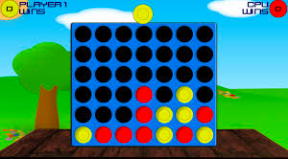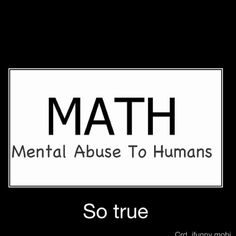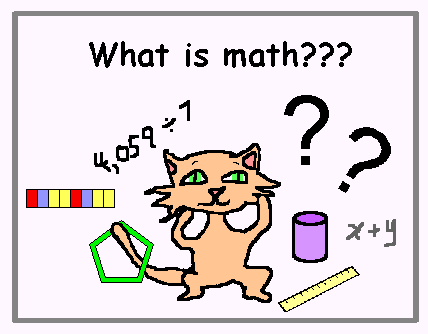In a recent task assigned by Richard we were asked to explore the fundamental mathematics of a game. I have decided to investigate the mathematics involved in the seemingly simple game of ‘Connect 4’.
Connect 4 is a game with relatively simple rules (Victor Allis, 1988):
- Each player in his turn drops one of his checkers down any of the slots in the top of the grid.
- The play alternates until one of the players gets four checkers of his colour in a row. The four in a row can be horizontal, vertical, or diagonal.(See examples).
- The first player to get four in a row wins.
- If the board is filled with pieces and neither player has 4 in a row, then the game is a draw.
There is no set rule which states who takes the first turn, this is ultimately left to the players to decide. This decision may be crucial in deciding who wins the game…
There are several different ways in which this game can be approached. By creating a simple rule player 1 (black) can ensure they win or draw every game. The rule is: Suppose n is even. Group the columns in pairs, giving pairs of columns 1 & 2, 3 & 4, …, (n-1) & n. Each time White plays in one column of a pair of columns, Black plays in the other column of the pair. For n is odd, groups are made in the same way, leaving the n-th column as a single column. The same rules apply to this position. Only if White plays in the n-th column, Black plays in that column, too.
Fundamental mathematics can be found in Connect 4 as the principles of probability and prescription are apparent. A player must attempt to predict where their opponent will place their next move. They must estimate the probability of their opponent predicting their next move and try to prevent them from making a move which will trap them and make them lose.
In relation to Liping Ma (2010) a player must have multiple perspectives when playing connect 4. This means that a person must be able to see the game in various ways and must be able to approach it in multiple ways. They must be aware that their opponent may have various moves available and they must be able to prevent any moves which will result in them losing. A person must also be able to take into consideration not just their opponents next move, but the next few moves they could make in order to guarantee a win. This could be done by recognising patterns they make.
When I played this game when I was younger I would try my best to place my counters in such a way that I create multiple opportunities for winning. For example create two lines of three meaning my opponent can only block one of my potential wins and leaving me with a guaranteed win. I would do this by considering possible patterns of play, trying to predict where my opponent would place counters to block mine but in some w ays it could be argued that the game is somewhat down to luck. For example your opponent may get distracted and miss an opportunity to win or fail to notice your plan.
ays it could be argued that the game is somewhat down to luck. For example your opponent may get distracted and miss an opportunity to win or fail to notice your plan.
Reference:
Victor Allis (1988), A knowledge based approach to connect-four, Available at:
http://www.informatik.uni-trier.de/~fernau/DSL0607/Masterthesis-Viergewinnt.pdf (Accessed on 27th November 2016)


 having two teachers who split our maths time between them. This resulted in us learning two completely separate topics at the same time which at such a high level was very confusing.
having two teachers who split our maths time between them. This resulted in us learning two completely separate topics at the same time which at such a high level was very confusing. n the two topics we were learning at the time. I also found it confusing when one teacher would explain something in one way and the other would
n the two topics we were learning at the time. I also found it confusing when one teacher would explain something in one way and the other would












 today’s input I had never really considered how our number system came about or in fact where maths in general came from. I found that discovering other number systems extremely interesting and creating our own was good fun too. This was also an opportunity to use some mathematical knowledge with creativity. Like many other groups in the class we tried to create a number system that symbolised the value of the number itself (1 dot for 1, 2 dots for the number 2, etc.), to us this seemed very logical. However had we placed our number system in front of someone from the Babylonian era, they would be completely baffled by our sense of logic.
today’s input I had never really considered how our number system came about or in fact where maths in general came from. I found that discovering other number systems extremely interesting and creating our own was good fun too. This was also an opportunity to use some mathematical knowledge with creativity. Like many other groups in the class we tried to create a number system that symbolised the value of the number itself (1 dot for 1, 2 dots for the number 2, etc.), to us this seemed very logical. However had we placed our number system in front of someone from the Babylonian era, they would be completely baffled by our sense of logic.

 ’s input my basic understanding of mathematics was the ability to use numbers to solve a problem or equation. However, maths is so much more than that. Maths involves many different key elements such as shape, size, patterns, and more which
’s input my basic understanding of mathematics was the ability to use numbers to solve a problem or equation. However, maths is so much more than that. Maths involves many different key elements such as shape, size, patterns, and more which throughout school. We sat down, opened our textbooks and listened to the teacher for some of the lesson and then were suddenly expected to have grasped the new concept and begin working through questions simply by listening and watching someone else solve a problem. Du Satoy’s article makes me question why did we never challenge maths in school? When told a rule for mathematics as a class we just accepted that that was the rule and there could be no other way. We would never question why. Perhaps this dulled our perception of maths in school too, the fact that we were taught not to question what we were told leaving us very unmotivated and uninspired.
throughout school. We sat down, opened our textbooks and listened to the teacher for some of the lesson and then were suddenly expected to have grasped the new concept and begin working through questions simply by listening and watching someone else solve a problem. Du Satoy’s article makes me question why did we never challenge maths in school? When told a rule for mathematics as a class we just accepted that that was the rule and there could be no other way. We would never question why. Perhaps this dulled our perception of maths in school too, the fact that we were taught not to question what we were told leaving us very unmotivated and uninspired. matics that is often left out of the “unadventurous curriculum” when in reality the discovery of fundamental mathematical principles were crucial in key historical moments. Without maths the Egyptians would not know how much stone was going to be required to build the pyramids in Giza. I had never thought of the endless creations that would have never happened if it wasn’t for the art of mathematics. I must admit that throughout High School I was always left wondering “when am I ever going to use maths?” Maths is all around us, without a basic understanding of mathematics we would struggle to survive everyday life. Mathematics opens doors to discovery and is full of potential breakthroughs and opportunities that could make the difference to the world.
matics that is often left out of the “unadventurous curriculum” when in reality the discovery of fundamental mathematical principles were crucial in key historical moments. Without maths the Egyptians would not know how much stone was going to be required to build the pyramids in Giza. I had never thought of the endless creations that would have never happened if it wasn’t for the art of mathematics. I must admit that throughout High School I was always left wondering “when am I ever going to use maths?” Maths is all around us, without a basic understanding of mathematics we would struggle to survive everyday life. Mathematics opens doors to discovery and is full of potential breakthroughs and opportunities that could make the difference to the world.